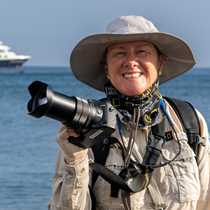Jackson Passage
When the sun rose this morning, there were already several folk out on the bow to watch the full moon set while the sky in the east started to fill with a rosy light. Two humpback whales breathed in the cool air at the entrance to Jackson Passage, a narrow fjord off Grenville Channel, dividing Roderick Island from Susan Island. Jackson Passage was named for Sheldon Jackson, the same Presbyterian minister who travelled in the north with John Muir. Sheldon Jackson left his mark here in British Columbia as well, establishing a mission in 1881 on nearby Long Island.
We had time to explore this morning, so down went the Zodiacs and kayaks, and out went the explorers. A “landing party” went ashore over slippery algae-covered rocks, but made it up to the forest edge, where they proceeded to meander over logs and rocks, taking in the intertidal and grassy borders of the temperate rainforest. The change in forest composition was already noticeable yesterday, but when I arrived outside this morning, the scent of cedar was in the breeze and oh-so-much-stronger. We found a lone Sitka spruce along the shore during the Zodiac cruise, and are now on the lookout for Douglas firs. Without a doubt, we were heading south.
Sandhill cranes were a great find in the back bay of the Jackson Narrows Marine Provincial Park. This is the far eastern end of Jackson Passage where, when the tide starts to flow, the current starts to rip. We visited during slack tide, so bull kelp and ribbon kelp clogged up the narrows and a harbor seal played hide and seek from our avid photographers with his huge red salmon chunk firmly clenched in his jaw.
The kayakers had the peacefulness of the fjord to themselves, and the time to watch red, blue, orange and purple “ochre” sea-stars hanging to the steep sides, not a ripple on the surface, offering stunning reflections. One lone sea star was found in a modest pose, hanging by one arm; patiently waiting for the rising tide to come and rescue it from its exposed location.
We left the protection of Jackson Passage and soon enough found ourselves out in Millbank Sound where large, slow swells put many to sleep in a lull after lunch. The afternoon, while always on the search for marine mammals, was also used to give a class on Adobe Lightroom, a program much in the minds of serious photographers these days. Later, Bette Lu gave a program on the people we would meet tomorrow—their history, and a bit of background in order to better prepare ourselves for a very special day.




